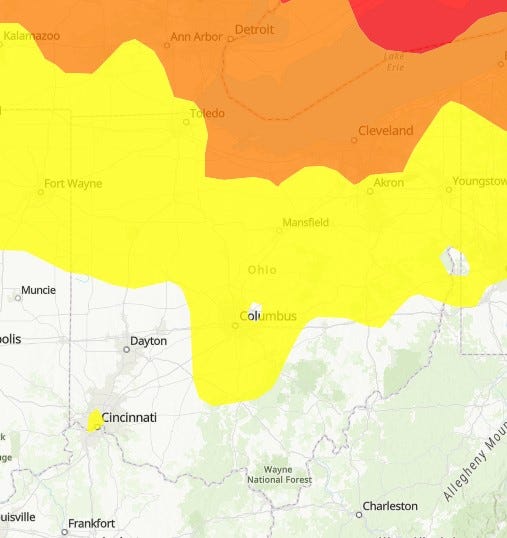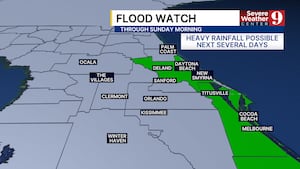Canadian wildfire smoke is impacting the air quality in northern Ohio.
AirNow, part of the Environmental Protection Agency, has issued an air quality alert for most of northern Ohio. The Air Quality Index is currently unhealthy for sensitive groups, according to AirNow.
The air quality will be unhealthy for sensitive groups — people with lung diseases like asthma, children and teenagers, older adults, and people who are routinely active outdoors for six or more hours a day.
Here’s what to know.
Ohio air quality index map for Aug. 4, 2025, showing index level orange, which indicates the air is unhealthy for sensitive groups or those active outdoors for an extended period.
What is the air quality index?
According to AirNow.gov, the air quality index is a measure running from 0 to 500, indicating the level of air pollution. The higher the number, the greater the air pollution.
Its six color-coded levels are:
-
Green: Good air quality, values from 0 to 50. Pollution poses little to no risk.
-
Yellow: Moderate air quality, values from 51 to 100. Some risk to people who are unusually sensitive to pollution.
-
Orange: Unhealthy for sensitive groups, values from 101 to 150. Members of sensitive groups may experience health effects. The general public likely won’t.
-
Red: Unhealthy, values from 151 to 200. The general public may experience health effects. It may be more serious for sensitive groups.
-
Purple: Very unhealthy, values from 201 to 300. At this stage, there is a health alert as the risk is increased for everyone.
-
Maroon: Hazardous, values of 301 and above. This is a health warning for emergency conditions, as everyone is more likely to be affected.
What is the air quality level in Northern Ohio on Aug. 4?
The air quality index in the Akron-Cleveland-Lorain area is 136, according to AirNow, placing the region solidly at the orange level.
The preliminary forecast for Aug. 5 shows Cleveland and the surrounding area with an air quality index of 101 or higher.
Similarly, the Toledo area had an index of 118 on Aug. 4, also within the orange level. AirNow did not show a forecast for Aug. 5.
How is an air quality alert issued?
According to the Southwest Ohio Air Quality Agency, if weather data and forecast information show that ozone or particulate matter may meet or exceed an air quality index of 101, an alert is issued.
What is ground-level ozone?
Ozone is a gas made up of three oxygen atoms. In the upper atmosphere, ozone is good, protecting the Earth from the sun’s ultraviolet rays. But at ground level, ozone is a harmful pollutant that is the main ingredient of smog, according to the EPA.
Ozone forms at ground level when pollutants emitted by cars, power plants, refineries and chemical plants, among others, chemically react in the presence of sunlight. Ozone is most likely to reach unhealthy levels on hot, sunny days in urban environments, according to the EPA. It can be carried by wind, spreading the pollution to rural areas.
What is fine particulate matter? Wildfires and other sources
Fine particulate matter are particles that are less than 2.5 microns in diameter. As a comparison, the average human hair is 50 to 70 microns thick. Breathing unhealthy levels of PM2.5 can increase the risk of heart disease, asthma and low birth weight, according to the New York State Department of Health.
According to the EPA, particulate matter can come from any number of sources. Sources include power plants, automobiles, construction sites or wildfires.
This article originally appeared on The Repository: Air quality alert issued for Northeast Ohio. What to know









